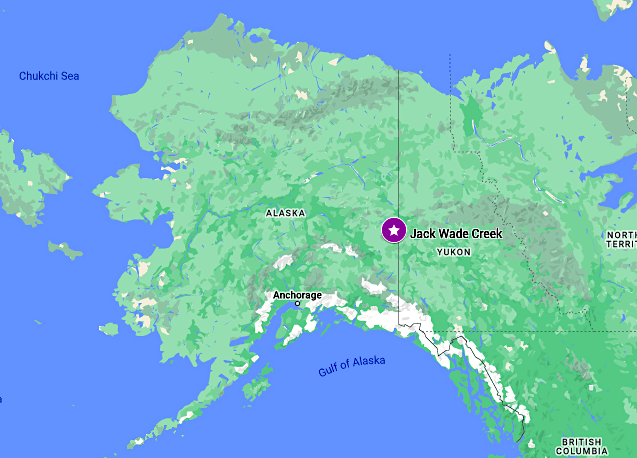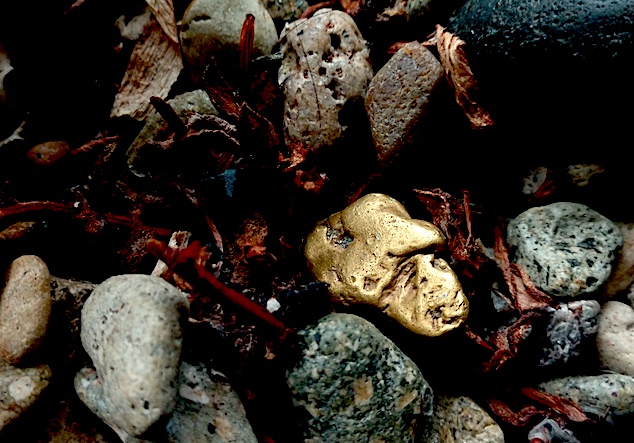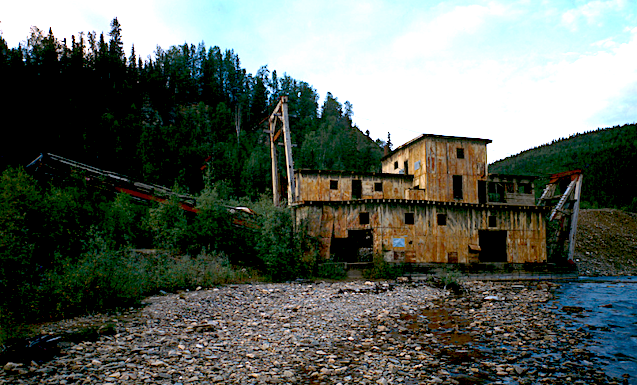The Jack Wade Creek Mining Area covers a narrow strip of placer deposits along Jack Wade Creek. It is located 20 miles east of historic mining town Chicken, within the Fortymile Mining District in Southeast Fairbanks, Alaska. Primary access on the US side is via the Taylor Highway out of Chicken.

Overview: Jack Wade Creek
Jack Wade Creek is a tributary of Walker Fork, which flows into South Fork, one of Fortymile River’s two main headwater sources. Historically considered one of the richest deposits in the district, the Jack Wade Creek mining area still supports active mining communities today.
The creek itself runs southwest along a straight narrow valley from the confluence of Grace and Warner Creeks in the north to Walker Fork near the Walker Fork Campground. Its name is a combination of the first names of the two prospectors – Jack Anderson and Wade Nelson – who discovered gold there in 1895 and filed the first claim.
Having been worked almost non-stop since mining commenced, the creek currently has productive working claims in the northern section. The southern section is open to the public for recreational prospecting.
How To Access Jack Wade Creek Mining Area
The Taylor Highway follows Jack Wade Creek along its entire 12-mile length and provides the main access to both the public panning grounds and the working claims. However, it closed in winter.
Camping At Jack Wade Creek Mining Area
If you want WiFi access, stay in Chicken and commute to the creek! It’s a 23-minute very scenic, very beautiful, drive. Otherwise, you can stay at the Walker Fork Campground located at the mouth of Jack Wade Creek. Note thought that there isn’t any WiFi at Walker Fork and definitely no cell-phone coverage either.
Camping is not permitted anywhere else along the creek.

The Walker Fork Campground has 18 sites. It provides good access to Jack Wade Creek. Camping fee is $10 per night.
Fortymile Wild and Scenic River Corridor
Jack Wade Creek is part of the Fortymile Wild and Scenic River Corridor, established in December 1980. It is however currently designated ‘recreational’ to allow its existing mining activities to continue.
Jack Wade Creek Public Recreational Panning Area Rules
The Jack Wade Creek public panning area starts a quarter of a mile from the Walker Fork campground. It runs for several miles along the creek up to Milepost 85 and the first of the mining claims. The following rules govern the use of this area:
Finding Gold At Jack Wade Creek
Jack Wade Creek has traditionally produced good-sized nuggets and coarse, sometimes iron-stained, flakes. Today, recreational ‘prospectors’ work through the old gravel tailings left by previous mining operations at the southern end of the creek.
Do they find much gold?
Surprisingly, they do and more than you’d expect of such well-worked tailings. Originally, the valley floor was covered in a layer of gravel between 3 and 13 feet deep, overlying a quartzite and broken schist bedrock. Most of the gold was reportedly found within the lower 1½ feet of gravel and top 3 feet of bedrock.

Jack Wade Creek can produce some nice sized gold nuggets. Metal detecting can be productive here.
Early extraction techniques for removing this gravel and bedrock were crude and often haphazard. Larger nuggets could be missed because they washed through the sluice boxes with the gravel. Furthermore, the gravel/bedrock contact wasn’t always thoroughly processed and some gold was invariably left behind.
Modern detection equipment makes finding this gold much easier, though it is still not easy work. You could go for days without finding anything significant apart from bits of scrap metal, or you could strike gold on your first try!
Jack Wade Creek’s Golden Past
Jack Wade Creek was originally mined with hydraulic systems that washed away the top layers of gravel and soil. The underlying gold bearing gravel and bedrock was then shovelled into the sluice boxes. After exiting the sluices, the gravel was left in waste piles and the outfit moved on to the next promising bit of ground.
In the upper parts of the creek, open cut and drift mining were also common. The drifts were usually made during winter when the ground was frozen. The excavated gravel was stock piled and left to thaw out before being run through sluice boxes over spring.
Larger hydraulic plants and mechanical steam shovels were brought in during the 1920’s and 1930’s. The famous Russell King dredge, for years a tourist attraction alongside Taylor highway, also arrived at the creek in 1936. It was abandoned in 1941 but not until it had produced some 70 – 100 ounces of gold a day during its peak.

The Jack Wade Dredge was a popular tourist attraction until 2007. The dredge had deteriorated badly, and the BLM had it dismantled and removed. A few pieces were moved to be displayed in Chicken, but much of the dredge was taken to the local dump.
WW2 brought a temporary halt to mining operations across the US as the government requisitioned their earth-moving equipment to aid the war effort. After the war, mining recommenced, usually with bulldozers and sluice boxes, and Jack Wade Creek continued to produce gold.
Gold In Jack Wade Creek Today
The creek’s largest operator ceased mining operations in 1951. Since then, most mining on the creek has been carried out by small operations using bulldozers and occasionally dredges.
Further, because it is now part of Fortymile Wild and Scenic River Corridor, miners take their environmental responsibilities very seriously. Many are addressing historic damage and rehabilitating the creek even as they mine.
The Epic Gold Rush History of Fairbanks
The Platinum Mining Dredges of Good News Bay
Alaska’s Largest Gold Nugget Discovered










